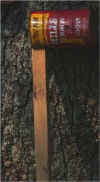| 09-13-04
The scarcity of mast, the seeds of trees, this year will emphasize the
importance of checking nuts you are collecting before you pick them up
and process them.
This is always an important safeguard against doing a lot of work for
nothing if the meats of nuts you harvest are not well developed. It is
doubly important this year because so few trees are bearing nuts this year.
Trees that did not have enough energy to produce a good crop this year
may also not have had sufficient energy to produce good kernels in the
meager crop of nuts they did produce.
In Indiana this applies to hickory and black walnut for the most part
(these are primary producers of edible nuts). But I am also finding that
the nuts of most of the beech trees I have checked are skimpy on meats.
The exterior of a nut can look very normal, but in many cases the nutmeats
are not well developed.
In the good years, I carry a Vise Grip, a hammer and a brick for use
in cracking and checking nuts--especially hickory and walnut--before I
pick them up. Even nuts that are well filled out and mature can change
after they are processed. This is just a chance the forager must take.
But if the meats of a nut are not fully developed before the nut falls,
it will not continue its development.
COFFEE CAN CUP--Harvesting black
walnuts and hickory nuts can be a back-breaking chore, but the late Ray
Fish, of Fishers, solved that problem many years ago with a two-pound coffee
can, a 90-degree metal bracket and a few screws and bolts.
Ray, who had a great grove of mature black walnut trees in his lawn,
faced the monumental task of picking up the crop of walnuts each year.
It was tough on his back. He solved the problem by attaching a sturdy three-foot
wood handle to a two-pound Hills Brothers coffee can.
With a five-gallon bucket to store the nuts he picked up, he simply
walked (with no back-bending) around his lawn, nudging the walnuts into
the coffee can with his foot, or scooping the nuts into the can with a
slight movement of the can. When the can held several nuts, he turned it
upside down to deposit the nuts in the bucket.
Click
on thumbnail image to see enlarged view.

|
| The
late Ray Fish invented his back-saver for picking up walnuts. |
CATALPA WORMS--It is a bit early
to be looking for catalpa worms for fish bait next summer, but the time
is ripe for looking for catalpa trees that probably will offer fish bait
next year.
True the larva of the catalpa sphinx (Ceratomia catalpae), that great
summertime fish bait, is long gone (they have no doubt burrowed into the
earth and have pupated). They will emerge next spring as adult moths and
deposit their eggs--probably on the underside of the leaves of the same
tree. The trees that were infested this year probably will host worms next
year. Their trademark is there for all to see.
In most cases, catalpa worms defoliate their host tree because they
feed voraciously on its leaves. This built-in natural phenomenon tells
the tree it must send forth more foliage when the worms have gone at midsummer.
The new leaves, on trees now, are much smaller than the original foliage.
That is a sure-fire tip that a tree offers the right chemistry for infestation.
Mark such trees well, and check them periodically next year for masses
of tiny white capsules on their leavesí undersides. When the tiny white
capsules show up in June or July, a good supply of fish bait will be there
soon. Incubation period is seven to 10 days.
(Additional information, pictures on catalpa worms will be found in
my August 4, 2003 column on this
website.)
|

